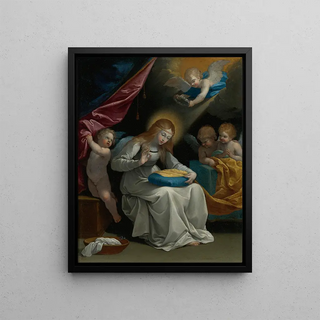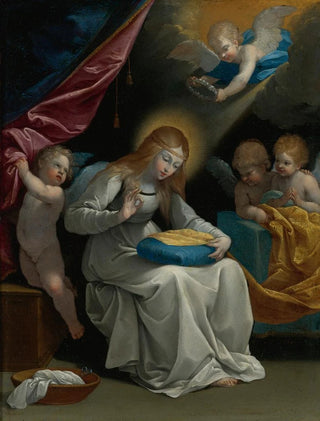Art print | The Virgin Sewing with Four Angels Known as The Seamstress - Guido Reni Source: Reproduction | La Vierge cousant accompagnée de quatre anges dite La Couseuse - Guido Reni


View from behind

Frame (optional)
In the rich and complex universe of baroque painting, Guido Reni's "The Virgin Sewing with Four Angels" stands out for its tenderness and spirituality. This artwork, which depicts an intimate and sacred scene, transports us to a moment of serenity, where the Virgin Mary, a central figure of Christian faith, is portrayed engaged in a daily activity, far from the tumult of the world. The angels surrounding her, delicately painted, add a celestial dimension to this representation, creating a perfect balance between the earthly and the divine. Through this art print, we are invited to contemplate not only Reni's remarkable technique but also the profound message of devotion and peace it conveys.
Style and uniqueness of the work
Mastery of light and shadow is one of the most striking features of Guido Reni's style. In "The Virgin Sewing," he uses delicate nuances to shape volumes and bring life to the angels' faces, while maintaining an atmosphere of calm and contemplation. The composition is skillfully orchestrated, each element arranged to guide the viewer's gaze toward the central figure of the Virgin. The color palette, dominated by soft and pastel tones, enhances the impression of tenderness and gentleness emanating from the piece. Reni manages to capture a moment of grace, where the sacred blends with the ordinary, a duality that makes this work deeply touching and accessible.
The artist and his influence
Guido Reni, born in Bologna in 1575, is one of the masters of Italian baroque. His career, marked by prestigious commissions and international recognition, testifies to his exceptional talent and lasting influence on European art. Reni successfully combined classical rigor with romantic sensitivity, allowing him to create highly expressive works. His innovative approach to light and color inspired many artists, and his style has been imitated and admired through the centuries. By depicting sacred figures with such humanity, he contributed to redefining the way art

Matte finish

View from behind

Frame (optional)
In the rich and complex universe of baroque painting, Guido Reni's "The Virgin Sewing with Four Angels" stands out for its tenderness and spirituality. This artwork, which depicts an intimate and sacred scene, transports us to a moment of serenity, where the Virgin Mary, a central figure of Christian faith, is portrayed engaged in a daily activity, far from the tumult of the world. The angels surrounding her, delicately painted, add a celestial dimension to this representation, creating a perfect balance between the earthly and the divine. Through this art print, we are invited to contemplate not only Reni's remarkable technique but also the profound message of devotion and peace it conveys.
Style and uniqueness of the work
Mastery of light and shadow is one of the most striking features of Guido Reni's style. In "The Virgin Sewing," he uses delicate nuances to shape volumes and bring life to the angels' faces, while maintaining an atmosphere of calm and contemplation. The composition is skillfully orchestrated, each element arranged to guide the viewer's gaze toward the central figure of the Virgin. The color palette, dominated by soft and pastel tones, enhances the impression of tenderness and gentleness emanating from the piece. Reni manages to capture a moment of grace, where the sacred blends with the ordinary, a duality that makes this work deeply touching and accessible.
The artist and his influence
Guido Reni, born in Bologna in 1575, is one of the masters of Italian baroque. His career, marked by prestigious commissions and international recognition, testifies to his exceptional talent and lasting influence on European art. Reni successfully combined classical rigor with romantic sensitivity, allowing him to create highly expressive works. His innovative approach to light and color inspired many artists, and his style has been imitated and admired through the centuries. By depicting sacred figures with such humanity, he contributed to redefining the way art






